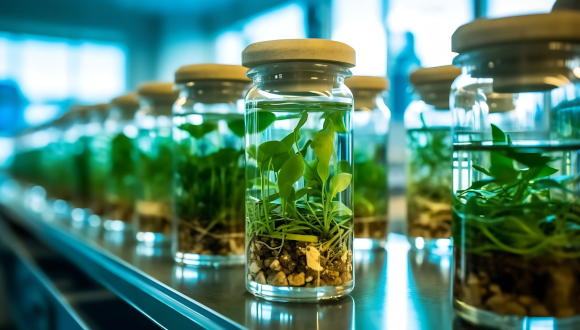TAU develops significant improvement to process of genetically cloning plants

Joint effort with the Volcani Institute could be significant for global agriculture
Support this researchResearchers from the School of Plant Sciences and Food Security at Tel Aviv University (TAU) and the Volcani Institute have developed new compounds that significantly increase the rooting efficiency of cuttings — typically small branches — taken from mature trees. Getting cuttings to root is a critical component in modern agriculture.
A significant number of fruit trees, as well as forest trees and ornamental plants, are based on cutting propagation: the creation of plants that are genetic clones of an individual with desirable characteristics. Improving the rooting process can contribute to global agriculture in a variety of aspects: developing new, high-quality varieties; lowering prices for farmers and consumers; increasing the economic viability of new cultivars of crops; and adapting crops to changing climate conditions.
The research was led by Dr. Roy Weinstain and research student Ohad Roth of TAU’s School of Plant Sciences and Food Security and Dr. Einat Sadot of the Institute of Plant Sciences at the Volcani Institute. The study was carried out in collaboration with researchers from the USA, Germany, Denmark, and England, and its results were published on January 24, 2024, in Nature Biotechnology.
“Vegetative propagation through cuttings is a method used to propagate plants asexually, not through seeds,” Dr. Sadot explains. “In this method, a branch is selected from a plant with desirable properties (e.g. fruit taste, drought resistance, disease resistance, etc.), and parts of that branch, called cuttings or propagules, are exposed to conditions that cause them to grow roots and become independent plants.
“The new individuals created in this way are actually clones, with the same genetics as the mother plant. In order for a crop to be economically viable, rooting percentages of at least 50-60% are necessary, and this figure is a significant consideration for farmers. Rooting percentages vary between different genuses of the same family, between different species of the same genus, and even between different cultivars of the same species, and there are important agricultural plants that are particularly difficult to root.”
To improve the percentage of plants developing roots, it is necessary to expose cuttings to the plant hormone auxin, a procedure developed more than 70 years ago and has hardly changed since. “The effectiveness of the existing auxin treatment varies from plant to plant,” Dr. Weinstain says. “There are numerous agriculturally important plants that hardly respond to the standard auxin treatment in terms of roots formation, and therefore cannot be commercialized. In our study we sought to increase the effect of auxin on the cuttings.”
The researchers first created a “library” of materials based on synthetic auxin conjugates — molecules in which a synthetic auxin is attached to another chemical group which neutralizes its activity but can be released slowly in plant cells. The library was tested using cuttings from a mature Eucalyptus grandis tree, which with standard auxin treatment reach low rooting percentages of only 10-15%.
“The initial examination identified a number of compounds that have a positive effect on the rooting process, and further research focused on the most effective one,” Roth says. “We discovered that this compound enables a combination of high permeability to the plant with a prolonged release of the active substance, the synthetic auxin, so that the auxin stays in the plant much longer, up to a week and a half.” Indeed, the upgraded treatment increased the rooting percentage of the Eucalyptus grandis cuttings to 60%, up to six times higher than the rooting percentages found using the standard method.
Later, in order to more deeply understand the new compound’s mode of action, the researchers used the model plant Arabidopsis thaliana. They discovered that the synthetic auxin used in the new material is more stable, breaking down more slowly in the plant cells compared to the auxin used in the standard treatment. In addition, the researchers identified a family of enzymes in the plant that are responsible for the release of the synthetic auxin.
“During the research, we developed a material that significantly improves the rooting percentages of cuttings from mature trees,” the researchers conclude. “The development could be significant for global agriculture in cost reduction, improved produce quality, and environmental compatibility.”